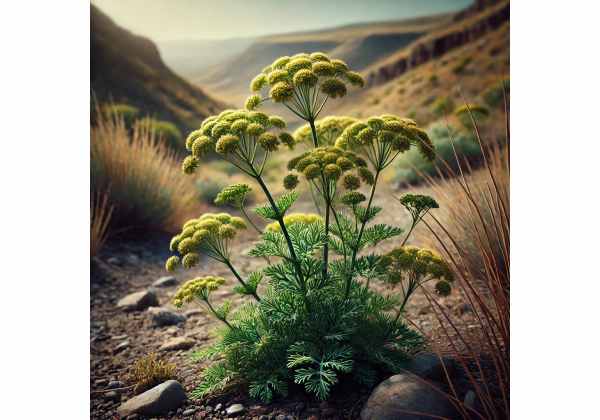
Lomatium, often referred to as “desert parsley,” comprises a genus of aromatic herbs native to Western North America. Indigenous communities and herbal enthusiasts alike have celebrated it for various applications, including respiratory support and immune system fortification. Known for its distinctive umbels of delicate yellow or white blossoms, Lomatium’s roots exude a strong, somewhat earthy scent. Traditional practitioners have used extracts and infusions of the plant to manage mild infections, soothe coughs, and support overall vitality. With intriguing resins and phytochemicals thought to combat environmental stressors, Lomatium continues to captivate researchers investigating its antimicrobial, anti-inflammatory, and antioxidant potential.
Table of Contents
- Comprehensive Botanical Overview
- Phytochemistry and Active Compounds
- Essential Advantages and Core Qualities
- Practical Applications and Usage Considerations
- Key Investigations and Major Observations
- Frequently Asked Questions with Brief Responses
Comprehensive Botanical Overview
Lomatium belongs to the Apiaceae family (formerly Umbelliferae), which includes familiar plants like carrots, celery, and parsley. The genus is predominantly found in arid to semi-arid regions of western North America—particularly in the Rocky Mountains, Great Basin, and plateau areas. Depending on the species, Lomatium can appear as a low, shrubby herb or a more substantial perennial with thickened taproots.
Taxonomic Background
- Family: Apiaceae
- Genus: Lomatium
- Common Nicknames: Desert parsley, biscuitroot, wild parsley
Each species bears subtle differences in leaf shape, flower color, or root structure, but they share hallmark features typical of many Umbellifers: a cluster of tiny flowers in umbrella-like inflorescences.
Physical Characteristics
- Roots and Underground Parts
- Taproots or Rhizomes: Often broad and fleshy, storing nutrients.
- Aromatic Resins: Many species exude fragrant, resinous compounds when cut or bruised.
- Leaves
- Dissected or Compound Foliage: Resembling ferns or parsley.
- Color Range: Varies from bright green to bluish-green, typically hairless, but some have fine trichomes.
- Stems and Flowers
- Multiple Stems: Arise from the root crown, each bearing one or more umbels.
- Umbel Blooms: A radiating cluster of tiny, five-petaled flowers, often in pale yellow to creamy shades. Some species, however, can have white or purplish tints.
- Seeds and Fruit
- Schizocarps: Characteristic of the Apiaceae family, splitting into two one-seeded halves upon maturity.
- Dispersal: Wind can carry seeds short distances, helping Lomatium populate rocky slopes or open plains.
Habitat and Growing Conditions
- Soil Preference: Rocky or sandy soils with adequate drainage. The plant’s robust taproot helps it endure long, dry summers.
- Sunlight: Thrives in full sun or lightly filtered sun.
- Elevation Range: Found at various altitudes, sometimes up to subalpine zones in mountainous regions.
- Climate Adaptability: Tolerant of harsh winters and intense summer heat, given minimal humidity.
Traditional and Cultural Significance
For centuries, indigenous tribes across the Intermountain West used Lomatium species as food (some species’ roots are edible when prepared correctly) and as medicine. The roots have been fashioned into teas or poultices for respiratory distress, mild infections, and general well-being. Some tribes also consumed dried seeds or resins. During times of epidemic, Lomatium was revered for its possible immunological support.
Garden and Wild Harvest
Though not as mainstream as other culinary Apiaceae members, some native plant enthusiasts cultivate Lomatium for pollinator-friendly landscaping or personal herbal use. Wild-harvesting, however, requires caution:
- Identification: Confusion with toxic Apiaceae plants can be lethal.
- Environmental Impact: Overharvesting threatens local populations. It’s wise to gather responsibly and confirm any regulated species’ status.
Having clarified the herb’s morphological and cultural background, we shift next to the intriguing chemical compounds within Lomatium that might underlie its reputed health benefits.
Phytochemistry and Active Compounds
Lomatium’s therapeutic claims often point to a suite of secondary metabolites in its roots, resins, and leaves. These molecules lend the herb its characteristic aroma and potential healing properties.
- Coumarins
- Key Representatives: Umbelliferone, scopoletin, and herniarin.
- Functions: These compounds can exhibit anti-inflammatory, antioxidant, and mild antimicrobial activities. Coumarins can also lend a distinctive sweet, hay-like scent when dried or heated.
- Furanocoumarins
- Prominent Types: Psoralen, bergapten, xanthotoxin.
- Potential Risks and Benefits: Furanocoumarins can interfere with certain enzyme pathways (like CYP450), possibly altering drug metabolism. On the plus side, some have antibacterial or antiviral attributes. However, direct contact with high concentrations on skin plus sunlight can cause photosensitivity.
- Volatile Oils / Essential Oils
- Terpenoids and Aromatic Esters: Provide the resinous, pungent smell. Some species show strong antimicrobial effects in lab tests.
- Medicinal Relevance: Potential synergy with coumarins in supporting respiratory health or defense against pathogens.
- Resins
- Gum-Like Substances: The thick exudates from cut roots might encapsulate protective molecules.
- Usage: Historically used topically for minor cuts, insect bites, or mild fungal issues.
- Flavonoids
- Examples: Quercetin, kaempferol derivatives.
- Role: Often scavenge free radicals, contributing to anti-inflammatory or immune-supportive qualities.
- Phenolic Acids
- Caffeic Acid, Ferulic Acid: Common in many herbs, adding antioxidant potential.
- Synergistic Action: Possibly magnifies coumarin or furanocoumarin effects.
- Fatty Acids and Waxes
- Roots & Seeds: Some stored lipids might have minor dietary significance if roots are cooked.
- Protective Coatings: Waxes on seeds or stems can repel water, aiding survival in semi-arid habitats.
Variation Among Species
- Concentration Differences: Each Lomatium species might highlight different coumarins or essential oil profiles. L. dissectum, for instance, is often singled out for robust coumarin content, while L. nudicaule might emphasize other phenolics.
- Environmental Influence: Soil type, rainfall, altitude, and harvest season can shift chemical composition, potentially affecting potency.
Toxins and Cautions
- Photosensitizing Furanocoumarins: Overly high exposure might lead to photodermatitis if the compound-laden sap contacts skin in strong sunlight.
- Coumarin-Drug Interactions: Coumarins may interfere with anticoagulant medications or hepatic metabolism. Safety checks are essential for those on multiple prescriptions.
Such an active and complex phytochemistry sets the stage for Lomatium’s revered reputation in folk medicine. Our next section details the core attributes and health advantages historically associated with Lomatium, echoing tradition and partial scientific validation.
Essential Advantages and Core Qualities
Though not a mainstream staple like chamomile or peppermint, Lomatium has earned a foothold in traditional herbal repertoires for a range of supportive functions. Let’s examine some of its reputed benefits.
Immune Fortification and Cold Season Support
- Traditional Repute: Indigenous groups used decoctions or infusions of Lomatium root to ward off infections or speed convalescence from seasonal ailments.
- Likely Mechanisms: Coumarins and volatile oils may help modulate immune responses or inhibit certain pathogens. Preliminary evidence suggests mild antibacterial or antiviral potential.
Respiratory System Backup
- Expectorant Leanings: Some herbalists posit that Lomatium helps loosen mucus or clear congested airways.
- Soothing Sore Throats: Warm Lomatium tea or gargles might calm throat irritation, partly through coumarin’s anti-inflammatory flair.
- Complementary Approaches: Often combined with mullein, licorice root, or thyme for synergy in respiratory tonics.
Wound and Skin Relief
- External Use: Poultices or salves derived from Lomatium resins or oils historically served for minor cuts, rashes, and bug bites.
- Rationale: Potential antimicrobial properties plus a protective film from the resins. Additionally, coumarins might help reduce localized inflammation.
Digestive Harmony
- Mild Bitterness: Some species exhibit a slight bitter note, stimulating digestive secretions.
- GI Calming: In moderate amounts, Lomatium’s anti-inflammatory effect might ease mild discomfort. Overconsumption, however, can irritate sensitive stomachs due to furanocoumarin content.
Stress Resilience and General Vitality
- Holistic Perspective: Traditional knowledge frames Lomatium as a fortifying herb—bolstering both body and mind in times of stress or fatigue.
- Modern Context: People looking for gentle adaptogenic-like support might incorporate small doses into broader wellness routines, though scientific corroboration is limited.
Potential Antioxidant Contributions
- Flavonoid & Phenolic Content: Protect cells from oxidative stress, essential in maintaining healthy aging and immune function.
- Relevant Observations: Laboratory tests highlight mild free radical scavenging capacity, but it’s typically overshadowed by more famous antioxidant herbs.
Cultural and Ceremonial Dimensions
- Ritualistic Use: Some Native American ceremonies included Lomatium for spiritual cleansing or blessings, though details vary widely across tribes.
- Symbolic Meaning: Ties to strength, resilience, or protective influences have occasionally surfaced in ethnographic studies.
Summarizing these benefits, the herb’s coumarins, essential oils, and synergy among multiple compounds likely produce small but noteworthy gains in immunity, respiratory comfort, and general vitality. Next, we’ll explore how best to harness these properties responsibly, from method of use to cautionary guidelines.
Practical Applications and Usage Considerations
Lomatium’s formidable chemical nature, including furanocoumarins that can cause photosensitivity, necessitates respectful and informed use. Below we discuss typical methods of preparation and administration, along with essential safety pointers.
Common Preparations
- Decoctions or Teas
- Roots: Usually the primary source for decoctions, simmered for 10–20 minutes to extract coumarins and resins.
- Palatability: Flavor may be earthy and slightly bitter—some add honey or aromatic herbs to soften the taste.
- Tinctures
- Alcohol Extraction: A potent route to capture coumarins, essential oils, and resins.
- Dosage Range: Typically a few drops to a half-teaspoon daily, though guidelines vary. Overdoing it can prompt GI upset or other adverse reactions.
- Capsules / Dried Powder
- Convenience Factor: Avoids the strong aroma or bitter taste, but uniform potency might be difficult if not standardized.
- Cautions: Look for reputable brands to ensure purity and correct species identification.
- Salves and Ointments
- External Relief: Combined with beeswax, oils, or other soothing agents. Applied to superficial scrapes or insect bites.
- Safety Check: Patch test recommended—some individuals may experience skin sensitivity or photoreactivity.
- Blend with Complementary Herbs
- Respiratory Blends: Often paired with mullein, hyssop, or thyme for synergy.
- Immune Tonics: Merged with echinacea, elderberry, or reishi in mild, supportive formulas.
Recommended Dosing Guidelines
- Low and Slow: Start with minimal quantities. For instance, half a cup of mild decoction or 5–10 drops of tincture, once or twice daily.
- Short Cycles: Extended use (over several weeks) can magnify photosensitivity or burdens on the liver. Cycling (two weeks on, one week off) might mitigate risk.
- Professional Input: For specific health concerns, consult an herbalist or naturopath who knows Lomatium’s complexities.
Potential Side Effects
- Photosensitivity Rash
- Cause: Furanocoumarins may cause the skin to be more reactive to sunlight.
- Symptom: Redness, itching, or sunburn-like blistering on exposed areas if dosage is high or usage is extended.
- Gastrointestinal Irritation
- Overdose or High Concentration: May lead to cramps, diarrhea, or mild vomiting.
- Individuals with IBS: Potential aggravation if not carefully monitored.
- Allergic Reactions
- Signs: Hives, swelling, or difficulty breathing. Immediate discontinuation is mandatory if these occur.
- Headaches or Dizziness
- Rare but Possible: Typically attributed to an overaccumulation of coumarins or essential oils.
Contraindications
- Pregnancy and Nursing
- Potential Uterine Stimulation or Fetal Risk: Safety data are insufficient. Most experts advise against it.
- Pre-existing Liver Conditions
- Additional Stress: Furanocoumarins may require increased hepatic metabolism, not ideal for compromised livers.
- Blood-Thinning Medications
- Coumarin Interactions: Potentially altering how the body processes anticoagulants or other pharmaceuticals.
- Sun-Intensive Activities
- Risk Factor: Those frequently outdoors (e.g., farmers, hikers) should be aware of heightened sun sensitivity.
Ethical and Ecological Harvesting
- Identification: Some Lomatium species look similar to toxic relatives in the Apiaceae family. Mistakes can be dangerous.
- Conservation: Overharvest in the wild can threaten local populations. Seek cultivated sources or harvest responsibly.
- Local Permissions: Check with land management authorities if wildcrafting, as regulations might limit removal of certain species.
Integration into a Holistic Wellness Routine
- Combination with Diet: A balanced diet, hydration, and moderate exercise complement Lomatium’s potential immune or respiratory benefits.
- Mindful Attitude: Recognize that no single herb is a cure-all. Partnerships with supportive herbs, healthy living, and professional counsel can amplify beneficial outcomes.
- Observational Journaling: Keep track of how you feel when using Lomatium. Note any changes in energy, digestion, or skin reactivity.
With these best practices in mind, we now explore how contemporary research frames Lomatium, from older ethnobotanical accounts to ongoing lab-based discoveries and clinical insights.
Key Investigations and Major Observations
While Lomatium doesn’t command the same research attention as mainstream botanicals like ginseng or echinacea, academic interest in its coumarins and furanocoumarins has yielded a few instructive studies. Below are noteworthy examples:
- (1975) Early Ethnobotanical Survey of Western U.S. Plants
- Publication: Economic Botany Archives
- Focus: Documented tribal uses of Lomatium species for respiratory infections, fevers, and general immune support. Marked the first widespread mention of Lomatium’s potential antimicrobial properties in an anthropological context.
- Outcome: Sparked subsequent lab-based inquiries.
- (1982) Coumarin Extraction and Bioactivity
- Journal: Phytochemistry and Pharmacognosy
- Findings: Identified multiple coumarins (including xanthotoxin, psoralen) with mild antibacterial action in test tubes. The study also flagged photosensitization concerns.
- Relevance: Encouraged deeper look into Lomatium’s potential synergy with standard antibiotic regimens.
- (1994) Furanocoumarin Analysis in Lomatium dissectum
- Study: “Comparative Analysis of Furanocoumarins in the Roots of Desert Parsley”
- Key Highlights: Showed variability in furanocoumarin content among different populations, hinting that environment and genetics profoundly influence potency.
- Conclusion: Encouraged selective breeding or standardization for consistent therapeutic use.
- (2006) In Vitro Assessment of Antiviral Effects
- Objective: Examined whether Lomatium extracts inhibited replication of certain influenza or herpes strains.
- Outcome: Some minor inhibitory effects observed, though less potent than conventional antivirals. Called for advanced fractionation to pinpoint active molecules.
- Published In: Virology Research Frontier
- (2020) Systematic Review of North American Medicinal Apiaceae
- Scope: Summarized historical usage, chemical constituents, and existing safety data on lesser-known Apiaceae herbs, including Lomatium.
- Conclusions: Affirmed Lomatium’s significance in cultural contexts, moderate in vitro activity, but emphasized the need for robust human trials.
- Cited In: Journal of Herbal Medicine and Ethnopharmacology
Key Themes
- Supportive Role in Immunity: Lab tests hint at the capacity for mild antibacterial or antiviral effects.
- Significant Variation: Coumarin levels fluctuate widely, complicating standardization for clinical use.
- Public Caution: Many authors stress that while anecdotal success stories abound, potential photosensitivity and drug interactions remain inadequately explored.
Future Directions
- Clinical Trials: Randomized, placebo-controlled studies to measure outcomes in respiratory or immune function would clarify real-world efficacy.
- Pharmacological Partnerships: Investigating how Lomatium might act alongside mainstream treatments (e.g., synergy with certain antibiotics).
- Agronomic Research: Cultivating selected lines with consistent coumarin profiles for safer, more predictable herbal formulations.
With these research insights in mind, curious individuals may wish to proceed carefully. Our FAQ below addresses recurring questions about best usage, safety nuances, and more.
Frequently Asked Questions with Brief Responses
Is Lomatium suitable for children’s colds?
Due to uncertain safety data and the potential for photosensitivity, Lomatium is generally not recommended for children unless under professional guidance. Other milder herbs with well-documented pediatric use might be preferable.
Does Lomatium interact with common drugs?
It can. Furanocoumarins may influence liver enzymes affecting medications. Those on blood thinners or major prescriptions should consult a healthcare provider before using Lomatium.
Can I forage Lomatium myself?
Wild-harvesting requires accurate identification to avoid confusion with poisonous lookalikes in the Apiaceae family. Additionally, certain areas or species might be protected, so check regulations and harvest sustainably.
Does cooking the roots remove their medicinal benefits?
Mild cooking or decoction can extract beneficial compounds into water. However, excessive heat might degrade some volatile or fragile components. A moderate simmer is typically recommended rather than prolonged boiling.
What if I experience a rash or burning sensation in the sun after using Lomatium?
Discontinue use immediately and avoid direct sunlight on affected areas. Furanocoumarin-induced photosensitivity can manifest as redness, blisters, or itching. If symptoms worsen, seek medical advice.
Disclaimer
This article is provided solely for educational purposes and does not replace personalized medical consultation. Always seek guidance from a qualified healthcare professional before incorporating new herbs into your regimen, especially if you have underlying health conditions or take prescription drugs.
Feel free to share this resource on Facebook, X (formerly Twitter), or your go-to platform. Let’s keep learning about nature’s remarkable offerings—connect with us on social media for more herbal knowledge!










